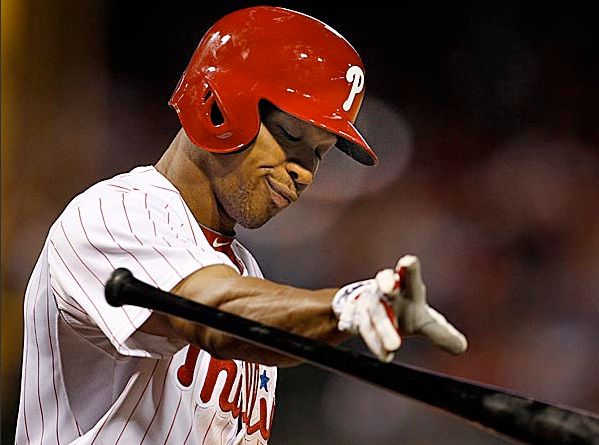

Things can’t get much worse for Ben Revere at the plate right now. Photo: AP
On December 6 of last year, the Phillies traded Vance Worley and top-prospect Trevor May to the Minnesota Twins for an exciting, young, free-swinging centerfield with a proclivity for putting the ball in play, finding ways to get on base and, once on, creating havoc with his blazing speed.
As of this post, that player has yet to arrive in Philadelphia. Instead, the player the Phillies acquired has been a nightmare at the plate.
To say it has been a poor start for Ben Revere in Philadelphia would be putting it extremely mildly. Ask any Phillies fan how Revere has played through his first month in red pinstripes, and you’d be certain to hear a much more colorful description of his play.
Rightfully so. There are not enough negative superlatives in the English language to adequately describe Revere’s offensive output. Sure, he’s displayed his fantastic speed. The only problem is, he never gets to show it off because he is never on base.
His .245 OBP currently ranks 24th among the 26 qualifying centerfielders in baseball, and is nearly 100 points lower than the .333 mark he posted last season. His .471 OPS ranks 25th. So far this year, Revere has combined a complete lack of power with a complete inability to get on base. It’s a rare and costly combination.
So what has the issue been for Revere?
The low OBP would cause one to guess he hasn’t been taking as many walks this season as he did last season. While the supposition is logical in theory, it’s untrue. Last season, Revere walked in 5.2% of his plate appearances. So far this season, he’s walked in exactly 5.0% of them, a nearly identical number. To compound that point, Revere has swung at less balls this year (25.6% this year versus 27.6% last year). In fact, many of Revere’s peripheral numbers are close to the same as last season. The only difference has been the results.
One area where Revere has struggled more this season, however, is with strikeouts. Last year, Revere struck out in just 9.8% of his at-bats, an impressive number. This year, Revere has struck out in 14% of the at-bats he’s had so far. And while that discrepancy doesn’t seem so drastic, it would mean five more balls in play for Revere over 100 PA, and five more opportunities to get use his speed to get on base. This helps explain why his infield hits per AB has been cut in half, down to 5.4% from 10.8% last season.
Something else Revere has done more of this season is hit the ball on the ground, while hitting less line drives. Last year, he posted a 66.9% groundball rate. This year, it’s up to 74.7%. In terms of line drives, he’s down from 18.6% last year to 13.3% this year. The result has been fewer extra base hits for the 24-year old, and by a wide margin. Through 100 PA last season, Revere had slugged seven extra base hits (5 doubles, two triples). This year, he has just one.
Finally, luck has been a culprit in Revere’s early-season struggles. Last season, Revere posted a BABIP of .325. His career mark is .302. But through the first month of this season, his BABIP has been a measly .241. On this alone, fans can expect to see improvement from the fleet-footed Revere.
All of these factors, some of them within Revere’s control, some of them not, have played a part in Revere’s first month–one of the grisliest I can ever remember. While Revere has dazzled in the field and been great on base when he does manage to get on, he is largely responsible for the .606 OPS Phillies outfielders are currently sporting, the worst among all outfield tandems in baseball. His offense has been so bad, that he’s currently a -0.6 WAR player, despite being above average in the field and as a baserunner.
It’s no wonder then that fans have begun lamenting the initial trade for Revere. The Phillies gave up a decent package for him. And while Worley has struggled (his ERA currently sits at 7.22), and May hasn’t proven to be anything more than a prospect, it’s impossible not to consider what else the Phils could have gotten for these trade pieces (a package with these two players and another prospect for Dexter Fowler, perhaps?)
Those ready to give up on Revere needn’t push the panic button just yet. After all, it’s only been one month and Revere’s numbers suggest stabilization is imminent.
Those who don’t believe in luck need to look no further than the Phillies other offseason targets for centerfield to understand what one month means. Among centerfielders, B.J. Upton, Denard Span, and Angel Pagan currently rank 24th, 21st, and 16th in OPS respectively. In other words, no matter who the Phils tabbed as their centerfielder for this season, if he wasn’t named Dexter Fowler, he was going to have a subpar first month. Revere, at least, is doing it at minimal cost.
Still, as the offense continues to search for consistent output, watching Revere struggle has become particularly infuriating. It seems like it’s only a matter of time before his numbers begin to show improvement. But for the Phillies, that day can’t come soon enough.